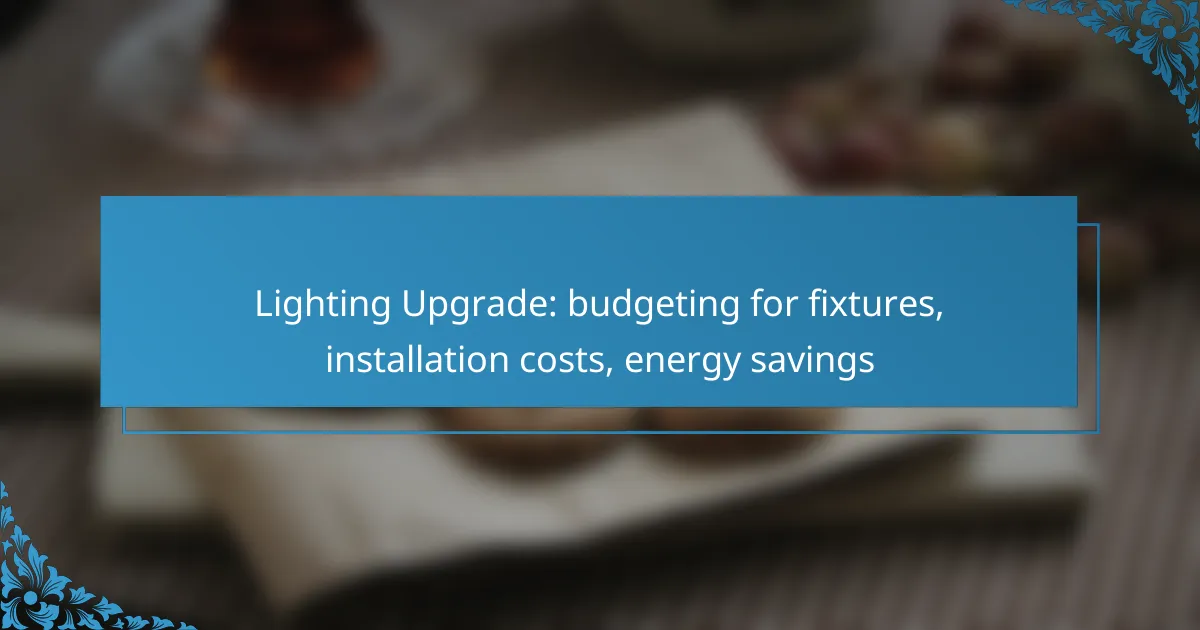Upgrading your lighting can be a significant investment, with costs for fixtures and installation in Toronto ranging from a few hundred to several thousand Canadian dollars. To effectively budget for this upgrade, it’s essential to consider not only the price of the fixtures and installation but also the potential energy savings that can offset initial expenses. A well-planned budget will ensure you maximize the benefits of your lighting investment.

What are the costs of lighting fixtures in Toronto?
The costs of lighting fixtures in Toronto can vary significantly based on the type of fixture, brand, and installation requirements. Generally, homeowners can expect to invest anywhere from a few hundred to several thousand Canadian dollars for a complete lighting upgrade.
Average price range for LED fixtures
LED fixtures are popular for their energy efficiency and longevity. In Toronto, the average price range for LED fixtures typically falls between CAD 50 and CAD 300 per unit, depending on the style and features.
For larger installations, such as recessed lighting or outdoor fixtures, costs can rise to CAD 500 or more per fixture. However, the initial investment is often offset by energy savings over time.
Cost of traditional fixtures
Traditional lighting fixtures, such as incandescent or fluorescent options, usually cost less upfront than LED fixtures. Prices for these can range from CAD 20 to CAD 150 per unit.
However, traditional fixtures tend to have shorter lifespans and higher energy consumption, which can lead to increased costs in the long run. It’s essential to consider both initial purchase price and ongoing energy expenses when making a decision.
Factors affecting fixture prices
Additionally, installation costs should be factored into the overall budget. Hiring a licensed electrician may add CAD 50 to CAD 100 per hour for labor, depending on the complexity of the installation. Always obtain multiple quotes to ensure competitive pricing.

What are the installation costs for lighting upgrades in Ontario?
The installation costs for lighting upgrades in Ontario can vary significantly based on several factors, including the type of fixtures, labor rates, and any required permits. Generally, homeowners should budget for both the cost of the fixtures and the associated installation expenses, which can add up to a few hundred to several thousand Canadian dollars.
Average labor costs for electricians
In Ontario, the average labor cost for electricians typically ranges from CAD 70 to CAD 120 per hour. The total labor cost will depend on the complexity of the installation and the time required to complete the job. For straightforward upgrades, homeowners might expect to pay for a few hours of labor, while more intricate installations could take significantly longer.
It’s advisable to obtain multiple quotes from licensed electricians to ensure competitive pricing and to verify their credentials. This can help avoid unexpected costs and ensure quality workmanship.
Permits and inspection fees
Depending on the scope of the lighting upgrade, permits may be required, especially for major electrical work. In Ontario, permit fees can range from CAD 50 to CAD 200, depending on the municipality and the nature of the project. Always check with local authorities to determine if a permit is necessary for your specific installation.
Inspection fees may also apply, particularly if the work involves significant changes to the electrical system. These fees can vary, so it’s important to factor them into your overall budget.
Cost variations by installation type
The cost of lighting upgrades can differ based on the type of installation. For instance, replacing existing fixtures with energy-efficient LED options is generally less expensive than installing new recessed lighting or smart home systems. Simple fixture replacements might cost a few hundred dollars, while more elaborate installations can exceed CAD 1,000.
Consider the long-term savings from energy-efficient fixtures when budgeting. While the initial investment may be higher, the reduction in energy bills can lead to significant savings over time, making it a worthwhile consideration for many homeowners.

How can I budget for a lighting upgrade?
To budget for a lighting upgrade, start by estimating the costs of fixtures, installation, and potential energy savings. A well-structured budget will help you manage expenses and maximize the benefits of your investment.
Creating a detailed budget plan
Begin by listing all necessary components for your lighting upgrade, including fixtures, bulbs, and installation services. Research the average costs for each item, which can vary significantly based on quality and brand, typically ranging from a few hundred to several thousand dollars depending on the scale of the project.
Include ongoing expenses such as energy costs and maintenance in your budget. Consider using energy-efficient options like LED fixtures, which may have a higher upfront cost but can lead to significant savings over time.
Identifying potential hidden costs
Hidden costs can arise from unexpected installation challenges, such as electrical upgrades or structural modifications. Always factor in a contingency of around 10-15% of your total budget to cover these unforeseen expenses.
Additionally, consider the costs of permits or inspections required by local regulations, which can vary by region. Researching these requirements in advance can help you avoid surprises that could derail your budget.
Financing options for upgrades
Explore various financing options to ease the burden of upfront costs. Many retailers offer financing plans, or you may consider personal loans, home equity lines of credit, or energy efficiency rebates from local utilities.
Check for government incentives or tax credits for energy-efficient upgrades, which can help offset costs. These programs often change, so stay informed about current offerings in your area to maximize your savings.

What energy savings can I expect from new lighting?
Upgrading to new lighting, particularly LED fixtures, can lead to significant energy savings. Many users report reductions in energy consumption of 50% or more compared to traditional lighting options.
Estimated savings from LED vs. traditional
LED lighting typically consumes about 75% less energy than incandescent bulbs and around 50% less than fluorescent lights. For example, replacing a 60-watt incandescent bulb with a 10-watt LED can save approximately $6 to $10 annually per bulb, depending on local energy rates.
Over time, these savings can accumulate significantly, especially in larger installations. For commercial settings, the transition to LED can result in thousands of dollars saved each year.
Long-term ROI on lighting upgrades
The return on investment (ROI) for lighting upgrades can be substantial, often recouping costs within 1 to 3 years. This calculation considers both the initial purchase and installation costs, as well as the ongoing savings on energy bills.
Additionally, many regions offer rebates or incentives for energy-efficient upgrades, which can further enhance ROI. It’s advisable to check local utility programs for potential financial benefits.
Impact of energy-efficient fixtures on bills
Switching to energy-efficient fixtures can lead to noticeable reductions in monthly electricity bills. For instance, a business that replaces 100 traditional bulbs with LEDs may see a decrease of several hundred dollars in energy costs each month.
Moreover, energy-efficient lighting often lasts longer, reducing replacement costs and maintenance efforts. This combined effect can significantly improve overall budget management for both residential and commercial properties.

What are the benefits of smart lighting systems?
Smart lighting systems offer enhanced control, energy efficiency, and convenience for users. By integrating technology, these systems allow for customizable lighting solutions that can adapt to various needs and preferences.
Energy management features
Smart lighting systems typically include energy management features that help monitor and reduce energy consumption. Users can set schedules or utilize motion sensors to ensure lights are only on when needed, leading to significant energy savings.
Many systems provide real-time data on energy usage, allowing homeowners to identify patterns and adjust their habits accordingly. This can result in lower electricity bills and a reduced carbon footprint.
Integration with home automation
Smart lighting can seamlessly integrate with other home automation systems, creating a cohesive smart home experience. This integration allows users to control lighting through voice commands, mobile apps, or centralized systems.
For example, lights can be programmed to turn on or off in conjunction with security systems or heating and cooling systems, enhancing overall home efficiency and security.
Cost savings over time
While the initial investment in smart lighting systems may be higher than traditional fixtures, the long-term cost savings can be substantial. Energy-efficient LED bulbs, often used in smart systems, consume significantly less power and have longer lifespans.
In addition to lower energy bills, many smart lighting solutions qualify for rebates or incentives in various regions, further offsetting initial costs. Over time, these savings can make smart lighting a financially sound choice for homeowners.

How do I choose the right fixtures for my space?
Choosing the right fixtures involves assessing your space’s specific needs, including functionality, size, and style. Consider the purpose of the area and how different lighting types can enhance its use and ambiance.
Factors to consider for residential vs. commercial
When selecting fixtures for residential spaces, focus on comfort and aesthetics, ensuring that the lighting complements the home’s design. In contrast, commercial spaces often prioritize functionality and energy efficiency, as they may require brighter lighting for productivity and safety.
For residential areas, consider the size of the room and the activities that will take place there. For example, kitchens may benefit from bright task lighting, while living rooms can use softer ambient lighting. In commercial settings, adhere to local regulations regarding brightness and energy consumption, which can vary significantly.
Style and aesthetic considerations
Your choice of fixtures should reflect the overall style of your space. For modern homes, sleek, minimalist designs work well, while traditional spaces may benefit from ornate fixtures. Consider how the lighting will interact with existing decor and color schemes.
Additionally, think about the finish and materials of the fixtures. Metals like brass or chrome can add a contemporary touch, while wood or vintage finishes may enhance a rustic or classic look. Always ensure that the fixtures provide adequate light without overwhelming the space visually.
